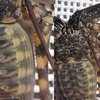Veribug
Arachnosquire
- Joined
- Mar 14, 2016
- Messages
- 86
Hello everyone 
So as a first time amblypygi keeper I actually struggled to find detailed info on D diadema pre/post molt care so I'm making this post to share my observations and also ask for help.
My observations of pre-molt:
- She stopped hunting aggressively at least 6 weeks before she molted.
- She would however pick up pre-killed crickets once every 2 weeks and half eat them. Possibly for moisture as she never drinks when I mist.
- In the last 1-2weeks before the molt she struggled to get around; her back legs lost their mobility and she stumbled around a bit on the polystyrene wall. When they say lethargic, she almost seemed unwell.
Now I have a question: Mine molted somewhere in the last 24-48hrs and although she's regained her dark colour, I don't know when is the appropriate time to try feeding her. Should I treat her similar to a T and wait a week? Or can it be sooner? I always find it hard to find this info so I'd love to hear from seasoned ambly owners thanks!
thanks!
So as a first time amblypygi keeper I actually struggled to find detailed info on D diadema pre/post molt care so I'm making this post to share my observations and also ask for help.
My observations of pre-molt:
- She stopped hunting aggressively at least 6 weeks before she molted.
- She would however pick up pre-killed crickets once every 2 weeks and half eat them. Possibly for moisture as she never drinks when I mist.
- In the last 1-2weeks before the molt she struggled to get around; her back legs lost their mobility and she stumbled around a bit on the polystyrene wall. When they say lethargic, she almost seemed unwell.
Now I have a question: Mine molted somewhere in the last 24-48hrs and although she's regained her dark colour, I don't know when is the appropriate time to try feeding her. Should I treat her similar to a T and wait a week? Or can it be sooner? I always find it hard to find this info so I'd love to hear from seasoned ambly owners

